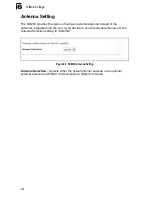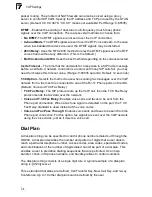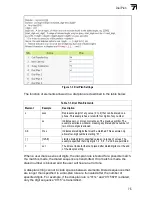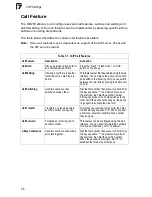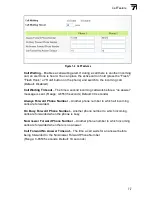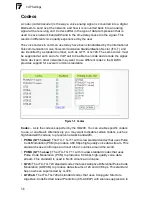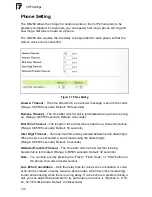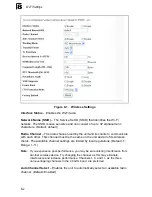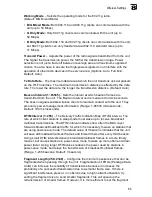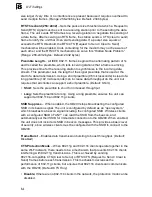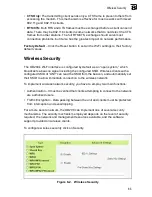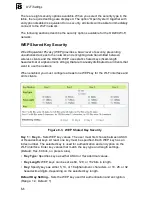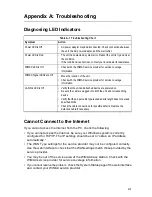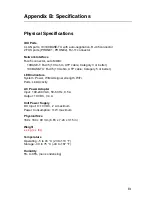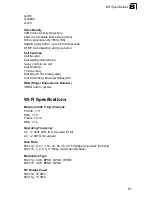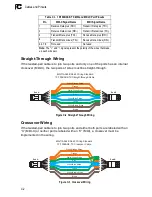
Wi-Fi Settings
8-4
8
size larger if very little or no interference is present because it requires overhead to
send multiple frames. (Range: 256-2346 bytes; Default: 2346 bytes)
RTS Threshold (256~2432)
– Sets the packet size threshold at which a Request to
Send (RTS) signal must be sent to a receiving station prior to the sending the data
frame. The unit sends RTS frames to a receiving station to negotiate the sending of
a data frame. After receiving an RTS frame, the station sends a CTS (clear to send)
frame to notify the unit that it can start sending data. If a packet size equals or
exceeds the RTS threshold, the RTS/CTS (Request to Send / Clear to Send)
mechanism will be enabled. Units contending for the medium may not be aware of
each other, and the RTS/CTS mechanism can solve this “Hidden Node Problem.”
(Range: 256-2432 bytes: Default: 2432 bytes)
Preamble Length
– All IEEE 802.11 frames begin with an alternating pattern of 1s
and 0s called the preamble, which tells receiving stations that a frame is arriving.
This provides time for the receiving station to synchronize to the incoming data
stream. This parameter sets the length of the signal preamble that is used at the
start of a data transmission. Using a short preamble (96 microseconds) instead of a
long preamble (192 microseconds) can increase data throughput on the unit, but
requires that all clients can support a short preamble. (Default: Short)
•
Short:
Sets the preamble to short for increased throughput.
•
Long:
Sets the preamble to long. Using a long preamble ensures the unit can
support all 802.11b and 802.11g clients.
SSID Suppress
– When enabled, the OD200 stops broadcasting the configured
SSID in its beacon signal. The unit is configured by default as an “open system,”
which broadcasts a beacon signal including the configured SSID. Wireless clients
with a configured SSID of “ANY” can read the SSID from the beacon, and
automatically set their SSID for immediate connection to the OD200. When enabled,
the unit does not include its SSID in beacon messages. This provides a basic level
of security, since wireless clients must be configured with the SSID to connect to the
OD200.
Frame Burst
– Enables data transmission bursting to boost throughput. (Default:
Disabled)
CTS Protection Mode
– When 802.11g and 802.11b clients operate together in the
same Wi-Fi network, there needs to be a mechanism that prevents 802.11b clients
interferring with 802.11g transmissions. This is achieved by sending
802.11b-compatible CTS (Clear to Send) or RTS/CTS (Request to Send / Clear to
Send) frames before each transmission. This mechanism decreases the
performance of 802.11g clients, but ensures that 802.11b clients can communicate
with the OD200. (Default:CTS Only)
•
Disable:
If there are no 802.11b clients in the network, the protection mode can be
disabled.
Summary of Contents for Edge-Core OD200
Page 1: ...Powered by Accton www edge core com User Guide OD200 Outdoor WiMAX Residential Gateway...
Page 2: ......
Page 4: ...OD200 E032008 CS R01 1...
Page 8: ...iv...
Page 12: ...viii Table of Contents Glossary Index...
Page 16: ...Figures xii...
Page 26: ...Introduction 1 10 1...
Page 36: ...2 10 Installing the OD200 2...
Page 58: ...System Settings 4 10 4...
Page 98: ...Wi Fi Settings 8 10 8...
Page 108: ...Cables and Pinouts C 4 C...
Page 118: ...Glossary Glossary 4...
Page 122: ...Index 4 Index...
Page 123: ......
Page 124: ...OD200 E032008 CS R01 1...

